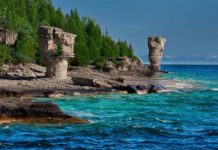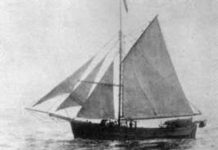The destruction of Huronia, the homeland of the Huron nation, by Iroquois war parties between 1648 and 1649 was an outcome of the bloody struggle to control the Canadian fur trade. The Huron and Algonquin peoples enjoyed the highly lucrative role of middlemen in this trade, a role which the Five Nations of the Iroquois Confederacy (Cayuga, Mohawk, Oneida, Onondaga, Seneca) sought to usurp by force. However, after years of mutually destructive warfare, their goal remained elusive.
An uneasy truce was established in 1645, when the tribes formalized a peace treaty and commercial alliance whereby the Hurons and Algonquins were to provide the Iroquois with supplies of furs to trade with their Dutch allies in Albany. Ultimately, the Iroquois gained nothing commercially from this arrangement, as the Hurons and Algonquins continued to deliver all their furs to the trading posts of their French allies on the St. Lawrence River. However, the peace did enable the Iroquois to recuperate from the earlier hostilities. In 1647, with their fighting strength restored, they embarked on a war of extermination against their enemies, preparatory to seizing control of the fur trade. Their initial target was the Huron nation.
Huronia in 1647
Huronia comprised the large and fertile territory bounded by Lakes Simcoe and Couchiching to the east, Georgian Bay and the Severn River to the North, Lake Huron to the west and Lakes Erie and Ontario to the South. Some twelve thousand Hurons lived there in thirty semi-permanent villages, most of which were located within several miles of one another. Each village consisted of twenty to thirty longhouse dwellings. The larger villages had up to two thousand inhabitants, and were fortified by three rings of wooden palisades: in times of danger, residents of the smaller settlements sought refuge within these walls.
Jesuit priests lived among the Hurons, striving to convert them to Christianity. By 1647, they has established twelve missions in Huronia, primarily in the larger villages: in these instances, traditional Huron place names typically gave way to French appellations (Teanaustaye, for example, became St. Joseph). They had also built a strongly fortified mission house at Ste. Marie on the Wye River in northwestern Huronia.
In the summer of 1647, Iroquois war parties began moving north from their country below Lake Ontario into Huronia. Raids by bands of Onondaga warriors forced the Hurons to abandon some outlying villages and consolidate their strength in the more populous settlements closer to Ste. Marie, as they braced for an onslaught.
1648 – The Iroquois Strike
On 4 July, a war party of one thousand Senecas attacked the village of St. Joseph, in the southern extremity of Huronia. Though one of the largest settlements, St. Joseph was particularly vulnerable: it was too far from other villages to be readily reinforced, and many warriors were away hunting or on hostile expeditions. Hundreds of Hurons were killed – many were burned alive as they cowered inside their longhouses, which the Senecas set ablaze – and seven hundred (mostly women and children) were taken prisoner: a few escaped and fled to other villages. The triumphant Iroquois plundered St. Joseph and burned it to the ground, flinging the body of Jesuit missionary Father Antoine Daniel onto the flaming remnants of his chapel. Then they withdrew to the east.
The annihilation of St. Joseph terrorized the Hurons. Twelve additional outlying villages were soon abandoned, and their former residents sought refuge at the Jesuits’ Ste. Marie stronghold. Yet, despite their fear of further attacks, the Hurons took few steps to strengthen the defenses of their remaining villages, even after scouts reported that most of the original Seneca war party – now reinforced by an army of Mohawks – was lurking inside Huronia’s eastern border. This combined force of twelve hundred warriors lived and hunted through the winter of 1648 – 49 in the forest north of Lake Ontario, waiting to strike.
1649 – The Iroquois Return
The timing of the second Iroquois assault was a brilliant stratagem. Indians usually made war when the trees were in full leaf to provide cover for surprise and swift retreat. However, the Seneca-Mohawk force struck the village of St. Ignace early on the morning of 16 March, when the deciduous trees were bare and snow still lay deep on the ground. Most of the Hurons were asleep when the Iroquois stole through the settlement’s makeshift fortifications, and were stabbed or tomahawked in their beds. Only three warriors escaped the slaughter: they raced north through the woods for three miles to the village of St. Louis, to warn of the impending attack. The Iroquois were right behind. They stormed St. Louis, breached its palisades in short order and killed most of the eighty Huron defenders. The survivors were taken prisoner, as were the Jesuit missionaries Jean de Brebouf and Gabriel Lalament, and the village was torched.
The majority of the Iroquois withdrew to St. Ignace to celebrate their victories and torture some of their prisoners (including Brebeuf and Lalament), while a party of about two hundred warriors remained near St. Louis. The following morning, this group travelled northwest towards Ste. Marie, intending to stage an initial assault on the Jesuit stronghold. They were intercepted by a relief force of three hundred Hurons and, in the subsequent fighting, the Iroquois were initially driven back to the ruins of St. Louis, then towards St. Ignace. At this point, the beleagured Iroquois were joined by hundreds of warriors from the main Seneca-Huron army and, in a furious counterattack, they killed every Huron. The route to Ste. Louis lay open, but the Iroquois had lost more than one hundred warriors that day. Rather than attack the fortified and forewarned mission with a weakened force, they decided to return to their own country with their rich harvest of scalps, prisoners and plunder.
The Huron Diaspora
The Iroquois departed, but the Hurons were certain they would return and believed nothing could be done to withstand their ferocity and superior firepower. To flee beyond their lethal reach seemed the only solution. Within weeks of the destruction of St. Ignace and St. Louis, fifteen more villages were abandoned. Most of their former residents sought refuge with tribes to the north and west of Huronia, and were eventually assimilated by them. Others went to live at the Ste. Marie mission, but with virtually all the villages destroyed or abandoned and their populations dispersed, the Jesuits had no reason to remain in Huronia. On 15 May 1649, they set fire to Ste. Marie’s buildings to prevent their desecration by the Iroquois and removed themselves, together with 300 Huron families, to St. Joseph Island on Georgian Bay. That winter, many of the party died from sickness or starvation: in the spring, the survivors scattered in various directions.
The Iroquois had achieved their objective in Huronia: the Huron nation was no more.
Sources:
- Costain, Thomas B. The White and the Gold: The French Regime in Canada.Doubleday & Company, Inc., Garden City, New York, 1954.
- Eccles, William J. The Canadian Frontier: 1534-1760. Holt, Rinehart & Winston Inc., Toronto, 1969.
- Hayes, John F. Wilderness Mission. The Ryerson Press, Toronto, 1969.
- Jury, Wilfred and Jury, Elsie McLeod. Sainte-Marie Among the Hurons. Oxford University Press, Toronto, 1954.







